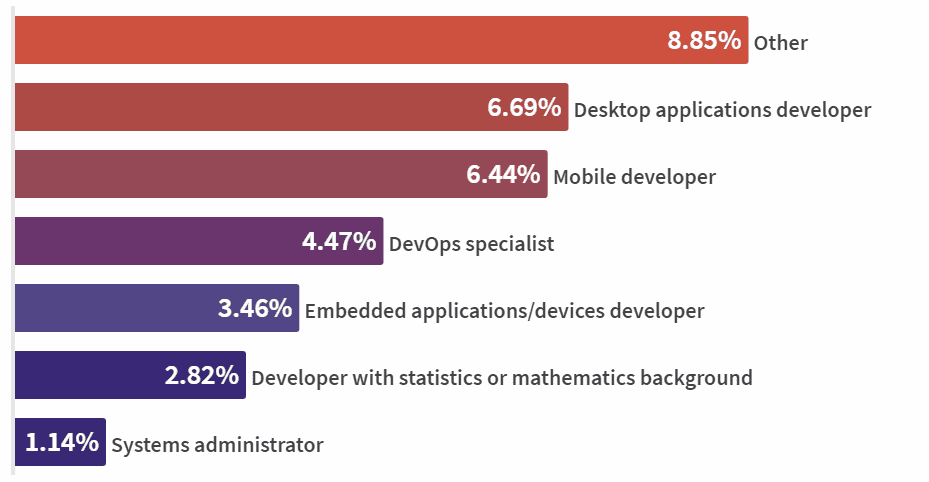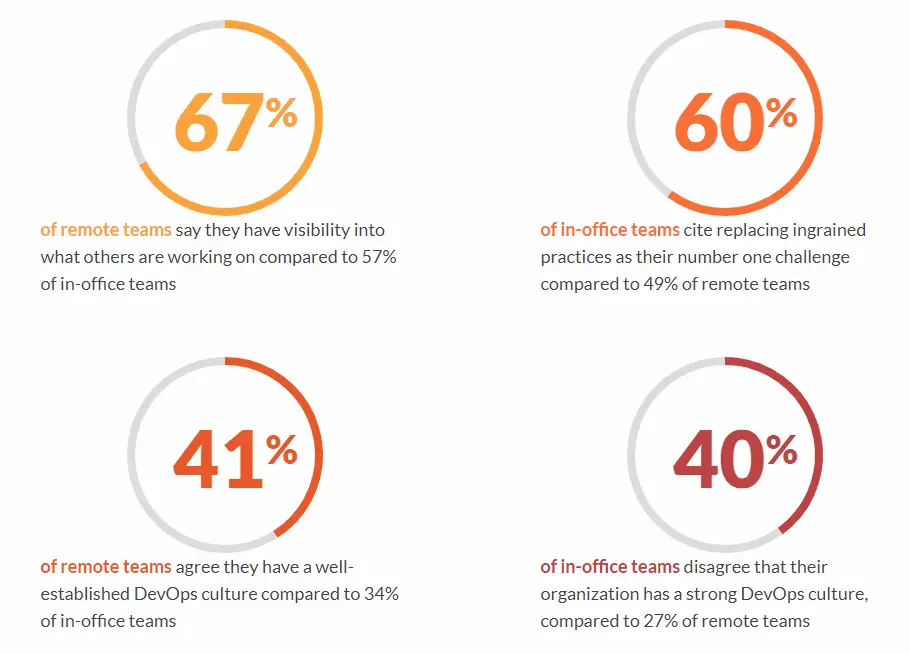
Recently, GitLab released a global developer report, which surveyed a total of 5296 software professionals from around the world. Most of them are software developers or engineers working in hardware, services, small business and SaaS industries.
The specific situation of the interviewed personnel
In this survey, 43.52% of the respondents served in the hardware, services, and SaaS industries, government, aerospace and defense, automotive, consumer goods manufacturing, energy and utilities, industrial manufacturing, biotechnology/pharmacy, insurance, food, and The proportion of other industries, such as health, is less than 8%. The status of other respondents is as follows:
 Most of the respondents were in SMEs, and 74.63% of respondents had less than 100 company developers. The specific situation is as follows:
Most of the respondents were in SMEs, and 74.63% of respondents had less than 100 company developers. The specific situation is as follows:
 Among them, 61.64% of software developers or engineers are web developers. The proportion of machine learning developers, graphics programming, DBA, and graphic designers is less than 1%. Other occupations are as follows:
Among them, 61.64% of software developers or engineers are web developers. The proportion of machine learning developers, graphics programming, DBA, and graphic designers is less than 1%. Other occupations are as follows:
 The main findings of the Global Developer Report:
The main findings of the Global Developer Report:
The GitLab Global Developer Survey lasted for one month. From feedback from more than 5,000 respondents, we found that software developers basically agreed with the value of highly collaborative work and experienced benefits from it. GitLab summed up six main findings from the survey:
1. Corporate leaders tend to be more optimistic about team overall satisfaction, productivity, and open source tools.
2. Almost everyone (81%) agrees with the importance of a collaborative environment, but the visibility and transparency of collaboration still lags behind, with 42% of developers saying that the report is not clear is the biggest challenge in the work.
3. Companies that have adopted DevOps are more likely to deploy on-demand and prioritize automated agility.
4. Efficient teams use better tools, spend less time on context switching, and are more likely to work remotely and efficiently.
5. On the whole, the team working remotely is more satisfied with the office than the office team. It mainly shows a higher level of visibility, a better deployment process, and a more powerful DevOps culture.
6. The 2018 IT leaders will invest in the following areas, including continuous integration, delivery, and deployment.
The current opportunities and challenges for enterprises
GitLab investigates the culture, workflow, and tool status of IT companies and tries to find out the differences between developers and IT managers. GitLab also studied the cultural differences between remote teams and office teams.
The study found that developers and senior management personnel maintain a high degree of cultural consistency, and both parties attach great importance to collaboration and communication. Management maintains a more optimistic attitude towards implementing DevOps, and 81% of managers agree with the view that 65% of developers agree. However, there are some cognitive differences in the frequency of code deployment, with 47% of managers saying that they will deploy code on demand or multiple times a day, compared with only 39% of developers.
Most managers stated that they will spend less than $10,000 in annual technical support in 2018.
Continuous integration, automation, and open source will be the most anticipated in 2018
47% of respondents believe that continuous integration will ease the obstacles encountered in the development process, and tool selection, tool integration, and internal processes are three major issues facing companies. Therefore, continuous integration, delivery, and deployment have tremendous application power for enterprises.
Compared with the office team, the overall satisfaction and productivity of the remote team are higher, and the automation of the software development lifecycle is a high priority for the enterprise.
 Emphasizing and prioritizing the use of open source tools is a common idea in all market segments. Regardless of level, culture, and workflow, open source is extremely important to the development team. In this survey, 92% of respondents stated that open source tools are Innovation is very important, 75% of respondents said that using open source tools is very important to them, and 84% of respondents said they prefer to use open source software through the closed source or proprietary tools. Compared with closed source software, open source tools can provide a variety of benefits, such as more secure, improve the overall software quality and simplify the development process.
Emphasizing and prioritizing the use of open source tools is a common idea in all market segments. Regardless of level, culture, and workflow, open source is extremely important to the development team. In this survey, 92% of respondents stated that open source tools are Innovation is very important, 75% of respondents said that using open source tools is very important to them, and 84% of respondents said they prefer to use open source software through the closed source or proprietary tools. Compared with closed source software, open source tools can provide a variety of benefits, such as more secure, improve the overall software quality and simplify the development process.
What tools do developers prefer?
As the technological environment continues to change and tools are selected more and more, choosing, implementing, and integrating the right tools becomes a major challenge. In this, open-source tools have received the warmest welcome from developers and are more suitable for security, innovation, and smooth development processes.
The survey shows that most developers use 3 to 6 tools to complete the development process, and one-third of respondents said they use cloud tools less than 19% of the time. However, interestingly, 27% of respondents said that they are using cloud tools from 80% to 100% of the time, and the two sides are evenly matched. More than half of respondents said they would spend about 40% of their time integrating tools, and some respondents said they spent less than 19% of their time. In addition, in daily work, 55% of the time is spent switching context between tools.
The report also gives the top three most important tools for the Agile team and the DevOps team. Let’s take a look together.

Source, Image: gitlab